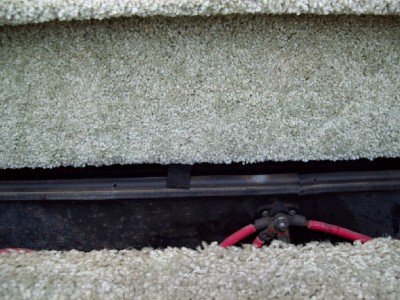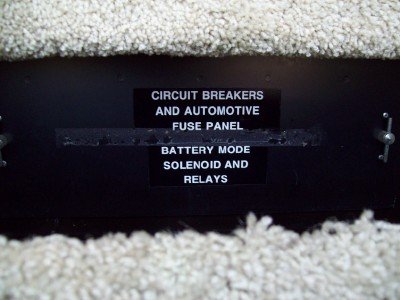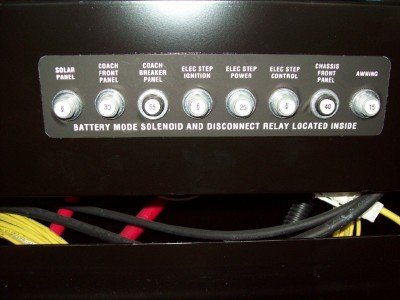Bill N
Well-known member
Sorry to look like I am posting more than my fair share of threads but I appreciated the help of the experts and others in solving the problems of a newbie. Now I would just like to post some information that may in the future help others who come into ownership wide eyed and ignorant.
While planning on replacing the pair of 6 volt house batteries on my 2002 Adventurer 35U, I pulled open the step under which they are located and saw how easy a job it will be. Then I noticed a little black tab hanging down from the vertical carpeted board above the step and gave it a little tug upon which it immediately fell down. It was held in place by a velcro strip that pulled loose from the backing. Behind that was a metal door with two quick release handles and some decals noting this was an area for battery circuit breakers and solenoid access (not exact phrasing). Opened that little panel and sure enough there are five or six circuit breakers mounted on a panel with ID decals for each of them (can't remember names at the moment). I do remember one was for the awning and three were for, as best I can recall, the sliders but that may be wrong. It was also obvious that this panel was only held by 4 screws and a lot of wiring and connectors were behind it.
The point here is none of this was mentioned in the owners manual and could be of interest to the owner who is trying to trouble shoot a specific problem but can't find the proper circuit breaker, solenoid or wire connection. I may try to take a photo later this morning but others may be able to better explain this area.
While planning on replacing the pair of 6 volt house batteries on my 2002 Adventurer 35U, I pulled open the step under which they are located and saw how easy a job it will be. Then I noticed a little black tab hanging down from the vertical carpeted board above the step and gave it a little tug upon which it immediately fell down. It was held in place by a velcro strip that pulled loose from the backing. Behind that was a metal door with two quick release handles and some decals noting this was an area for battery circuit breakers and solenoid access (not exact phrasing). Opened that little panel and sure enough there are five or six circuit breakers mounted on a panel with ID decals for each of them (can't remember names at the moment). I do remember one was for the awning and three were for, as best I can recall, the sliders but that may be wrong. It was also obvious that this panel was only held by 4 screws and a lot of wiring and connectors were behind it.
The point here is none of this was mentioned in the owners manual and could be of interest to the owner who is trying to trouble shoot a specific problem but can't find the proper circuit breaker, solenoid or wire connection. I may try to take a photo later this morning but others may be able to better explain this area.



